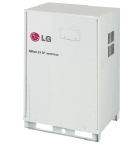Water-cooled VRF is geothermal ready

LG’s Multi V Water II geothermal-ready product is a VRF water-cooled system designed for high-rise buildings. Up to 64 indoor units can be connected to provide heating and cooling. It also features an instant-water-heating function. This system can be applied to multiple applications — geothermal, boiler/cooling tower, or a hybrid of both. Tests have shown that the COP of the water-cooled Multi V Water II is up to 28% better than an air-cooled system.
Longer piping lengths mean that extra zones can be reached from the same VRF units, reducing installation costs.
Cooling and heating can be provided in different zones at the same time, improving energy efficiency if heat extracted from one zone can be used for heating in another — in addition to water-side heat recovery.
Water or an anti-freeze solution can be circulated through closed-loop polyethylene pipes buried in the ground to provide a highly efficient solution.
The space required for outdoor units is reduced by up to 60% compared with air-cooled equipment. The light weight, compact size and stackability of indoor units make it easy to install them in indoor plant rooms.
Units are available in 10 and 20 hp versions. 10 hp units have an inverter-driven scroll compressor. 20 hp units have one inverter-driven and one fixed-speed scroll compressor.
There is a no-quibble 5-year warranty for equipment supplied and fitted by LG-approved installers.







